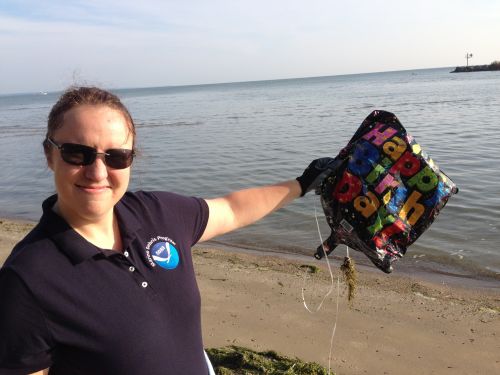Minds Behind OR&R: Meet Marine Debris Scientist Sarah Lowe
This is the 11th in a monthly series profiling scientists and technicians who provide exemplary contributions to the mission of NOAA’s Office of Response and Restoration (OR&R). This month’s featured scientist is Marine Debris Program Great Lakes Regional Coordinator Sarah Lowe.
By Alexis Thorbecke, NOAA Marine Debris Program
Sarah Lowe is the Great Lakes regional coordinator for the Marine Debris Program and is based in Oak Harbor, Ohio. In this role, she works with partners across eight states in the U.S. and the Canadian province of Ontario to address the problem of marine debris in our Great Lakes.
Sarah is uniquely able to bring this vast region together partially because she truly is a member of that community. The Great Lakes have been a part of her life since she was a small child and her fondest memories growing up are of fishing, camping, and exploring on the shores of Lake Erie. However, her passion for aquatic ecosystems was really ignited during a marine biology class in high school.
She took that passion to Bowling Green State University where she received her bachelor's in biology and eventually her master’s studying heavy metals in lake sediments and their effects on mayfly larvae. She has previously worked on other important Great Lakes issues. As a research technician, Sarah documented aquatic invasive species interactions between the round goby and smallmouth bass, as well as industrial impacts to fisheries when she was part of a team evaluating the effects of coal-fired power plants on local fish species.
Sarah first joined NOAA as a John A. Knauss Marine Policy fellow in 2009, during the very early years of the Marine Debris Program. At the time, the program was about half its current size, and marine debris was not on the public consciousness the way it is today. Sarah did not know much about the issue. As she started her work helping to standardize monitoring procedures for the Marine Debris Monitoring and Assessment Project, she realized the enormity of the problem. When the opportunity came about to become the Great Lakes Coordinator of this fledgling program, Sarah jumped at the chance to bring what she had learned in Silver Spring back to her own community.
Until 2015, Sarah also shared time with the NOAA Restoration Center, where she assisted in the management of Great Lakes Restoration Initiative projects, provided technical assistance on restoration techniques to regional partners, participated in natural resource damage assessment cases, and worked with Great Lakes Areas of Concern on restoration and assessing the integrity of the ecosystem.
Addressing debris in the Great Lakes isn’t always easy, there are many challenges that are unique to this region. It is one of the largest regions and is managed by two different countries — the U.S. and Canada. It is also freshwater, which makes it unique to the other regions of the Marine Debris Program. Plastics behave differently in the vast windswept waters of the lakes. Research indicates that debris tends to be break into smaller pieces in the lakes as compared to our world ocean, and since many communities get their drinking water from the lakes, things like microplastics become a huge health concern.
Sarah isn’t daunted by the scope of the problem in front of her. She says working with the young students in her community makes it all worthwhile. Her strong sense of place drives her to help kids fall in love with and care for the lakes the way she has.
“When you see the light bulb go off, it really hammers home why we do what we do,” she said.
When not at work, Sarah loves to travel, read, and spend time with her family on the shore of the lake where she grew up.

 An official website of the United States government.
An official website of the United States government. 
